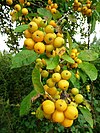bio.wikisort.org - Plant
Malus angustifolia, or southern crabapple,[3] is a species of crabapple native to the eastern and south-central United States.
| Malus angustifolia | |
|---|---|
Conservation status | |
| Scientific classification | |
| Kingdom: | Plantae |
| Clade: | Tracheophytes |
| Clade: | Angiosperms |
| Clade: | Eudicots |
| Clade: | Rosids |
| Order: | Rosales |
| Family: | Rosaceae |
| Genus: | Malus |
| Species: | M. angustifolia |
| Binomial name | |
| Malus angustifolia | |
 | |
| Natural range | |
| Synonyms[2] | |
| |
Description
M. angustifolia is a tree sometimes attaining a height of 10 meters (33 feet). The trunk can have a diameter up to 25 centimeters (10 inches). The flowers are pink, with a pleasant scent. The fruits are up to 3 cm (1+1⁄4 in) in diameter, and have an aromatic scent and a pear-like shape.[4][5]
Taxonomy
The following two varieties are known:[2]
- Malus angustifolia var. angustifolia
- Malus angustifolia var. puberula (Rehder) Rehder
Distribution and habitat
The species can be found from Florida west to eastern Texas and north to New Jersey, Pennsylvania, Illinois and Missouri.[6]
Ecology
The fruits are eaten by various wildlife.[7]
Uses
Although the fruits are astringent, acidic, and unpalatable when raw, they can be used to make jellies, jams, and food preserves.[4][5]
The tree is grown as an ornamental plant.
References
- IUCN SSC Global Tree Specialist Group.; Botanic Gardens Conservation International; et al. (BGCI) (2020). "Malus angustifolia". IUCN Red List of Threatened Species. 2020: e.T64134490A152906529. doi:10.2305/IUCN.UK.2020-1.RLTS.T64134490A152906529.en. Retrieved 19 November 2021.
- The Plant List, Malus angustifolia (Aiton) Michx.
- "Search results for: Malus". Archived from the original on April 4, 2010. Retrieved September 11, 2009.
- Flora of North America, Malus angustifolia (Aiton) Michaux, 1803. Southern or narrow-leaved crabapple
- Malus angustifolia at Plants for a Future
- Biota of North America Program, 2014 county distribution map
- Little, Elbert L. (1980). The Audubon Society Field Guide to North American Trees: Eastern Region. New York: Knopf. p. 489. ISBN 0-394-50760-6.
External links
- Carolina Nature
- Lady Bird Johnson Wildflower Center, University of Texas
- Louisiana Plant Identification
- Leafsnap.com: Images of the Southern Crabapple (Malus angustifolia)
На других языках
- [en] Malus angustifolia
[ru] Яблоня узколистная
Я́блоня узколи́стная (лат. Mālus angustifōlia) — дерево, вид рода Яблоня (Malus) семейства Розовые (Rosaceae), произрастающее на юго-востоке США[2].Другой контент может иметь иную лицензию. Перед использованием материалов сайта WikiSort.org внимательно изучите правила лицензирования конкретных элементов наполнения сайта.
WikiSort.org - проект по пересортировке и дополнению контента Википедии

